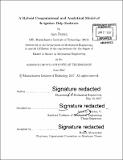| dc.contributor.advisor | Amos G. Winter, V. | en_US |
| dc.contributor.author | Narain, Jaya, (Scientist in Mechanical Engineering) Massachusetts Institute of Technology | en_US |
| dc.contributor.other | Massachusetts Institute of Technology. Department of Mechanical Engineering. | en_US |
| dc.coverage.spatial | a-ii--- | en_US |
| dc.date.accessioned | 2017-10-04T15:04:49Z | |
| dc.date.available | 2017-10-04T15:04:49Z | |
| dc.date.copyright | 2017 | en_US |
| dc.date.issued | 2017 | en_US |
| dc.identifier.uri | http://hdl.handle.net/1721.1/111708 | |
| dc.description | Thesis: S.M., Massachusetts Institute of Technology, Department of Mechanical Engineering, 2017. | en_US |
| dc.description | Cataloged from PDF version of thesis. | en_US |
| dc.description | Includes bibliographical references (pages 63-65). | en_US |
| dc.description.abstract | This thesis details a hybrid computational and analytical model to predict the performance of inline pressure-compensating (PC) drip emitters. A verified CFD model is used to predict flow behavior through tortuous paths. A method of extracting a pressure scaling parameter from the CFD results for use in an analytical model is presented. Analytical expressions that describe the bending of asymmetric rectangular membranes in inline drip emitters are detailed. These expressions are combined with finite element analysis (FEA) describing the shearing behavior of the membrane to model the total flow resistance through the emitter. Analytical expressions that describe the fluid mechanics of duct and turbulent flows are used to predict the net flow rate out of the emitter. The final model is verified for three distinct emitter geometries. The hybrid model presented in this paper has wide applicability - it can be applied to asymmetrical emitter geometries that have tortuous paths and other complex flow geometries. The hybrid model benefits from the accuracy of computational modeling for complex flows and contact interactions, and the processing speed of analytical models. Because of its accuracy and speed, the model can be used reliably as a design tool for inline PC emitters. | en_US |
| dc.description.statementofresponsibility | by Jaya Narain. | en_US |
| dc.format.extent | 65 pages | en_US |
| dc.language.iso | eng | en_US |
| dc.publisher | Massachusetts Institute of Technology | en_US |
| dc.rights | MIT theses are protected by copyright. They may be viewed, downloaded, or printed from this source but further reproduction or distribution in any format is prohibited without written permission. | en_US |
| dc.rights.uri | http://dspace.mit.edu/handle/1721.1/7582 | en_US |
| dc.subject | Mechanical Engineering. | en_US |
| dc.title | A hybrid computational and analytical model of irrigation drip emitters | en_US |
| dc.type | Thesis | en_US |
| dc.description.degree | S.M. | en_US |
| dc.contributor.department | Massachusetts Institute of Technology. Department of Mechanical Engineering | |
| dc.identifier.oclc | 1003859123 | en_US |
